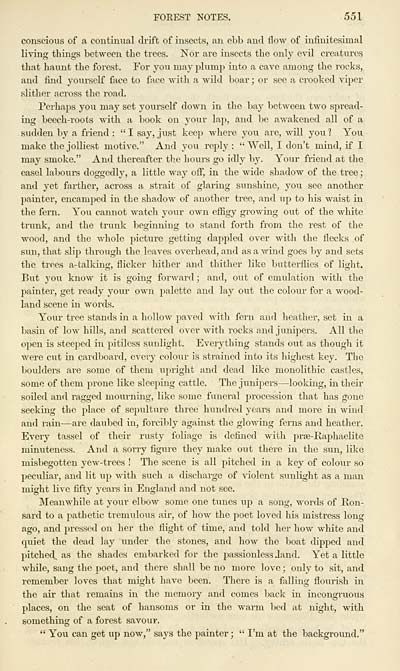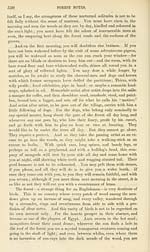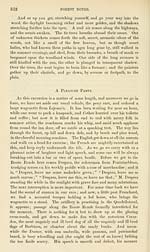Non-Fiction > Uncollected essays > Volumes 33-38, 1876-1878 - Cornhill magazine > Volume 33
(15) Page 551
Download files
Complete book:
Individual page:
Thumbnail gallery: Grid view | List view

FOREST NOTES. 551
conscious of a continual drift of insects, an ebb and flow of infinitesimal
living things between the trees. Nor are insects the only evil creatures
that haunt the forest. For you may j^lump into a cave among the rocks,
and find yourself face to face with a wdd boar ; or see a crooked viper
slither across the road.
Perhaps you may set yourself down in the bay between two spread-
ing beech-roots with a book on your lap, and be awakened all of a
sudden by a friend : "I say, just keep where you are, wUl you"? You
make thejolliest motive." And you reply: "Well, I don't mind, if I
may smoke." And thereafter the hours go idly by. Your friend at the
easel laboui-s doggedly, a little way off, in the wide shadow of the tree ;
and yet farther, across a strait of glaring sunshixie, you see another
painter, encamped in the shadow of another tree, and up to his waist in
the fern. Yovi cannot watch your own efligy growing out of the white
trunk, and the trunk beginning to stand forth from the rest of the
wood, and the whole picture getting dappled over with the flecks of
sun, that slip through the leaves overhead, and as a wind goes by and sets
the trees a-talking, flicker liither and thither like butterflies of light.
But you know it is going forward; and, out of emulation with the
painter, get ready your own palette and lay out the coloui- for a wood-
land scene in words.
Your tree stands in a hollow paved Avith fern and lieather, set in a
basin of low hills, and scattered over with rocks and junipers. All tlie
open is steeped in pitiless sunlight. Everything stands out as though it
were cut in cardboard, every colour is strained into its highest key. The
])Oulders are some of them upright and dead like monolithic castles,
some of them prone like sleeping cattle. The junipers — looking, in their
soiled and ragged mourning, like some funeral procession that has gone
seeking the place of sepulture three hundred years and more in wind
and rain — are daubed in, forcibly against the glowing fems and heather.
Every tassel of their rusty foliage is defined with prse-Raphaelite
minuteness. And a sony figure they make oxit there in the sun, like
misbegotten yew-trees ! The scene is all pitched in a key of colour so
peculiar, and lit up with such a discharge of \-iolent sunlight as a man
might live fifty years in England and not see.
Meanwhile at your elbow some one tunes up a song, words of Ron-
sard to a pathetic tremulous air, of how the poet loved his mistress long
ago, and pressed on her the flight of time, and told her how white and
quiet the dead lay under the stones, and how the boat dipped and
pitched, as the shades embarked for the passionless Jand. Yet a little
while, sang the poet, and there shall be no more love ; only to sit, and
remember loves that might have been. There is a falling flourish in
the air that remains in the memory and comes back in incongruous
places, on the seat of hansoms or in the warm bed at night, with
something of a forest savour.
" You can get up now," says the painter; " I'm at the background."
conscious of a continual drift of insects, an ebb and flow of infinitesimal
living things between the trees. Nor are insects the only evil creatures
that haunt the forest. For you may j^lump into a cave among the rocks,
and find yourself face to face with a wdd boar ; or see a crooked viper
slither across the road.
Perhaps you may set yourself down in the bay between two spread-
ing beech-roots with a book on your lap, and be awakened all of a
sudden by a friend : "I say, just keep where you are, wUl you"? You
make thejolliest motive." And you reply: "Well, I don't mind, if I
may smoke." And thereafter the hours go idly by. Your friend at the
easel laboui-s doggedly, a little way off, in the wide shadow of the tree ;
and yet farther, across a strait of glaring sunshixie, you see another
painter, encamped in the shadow of another tree, and up to his waist in
the fern. Yovi cannot watch your own efligy growing out of the white
trunk, and the trunk beginning to stand forth from the rest of the
wood, and the whole picture getting dappled over with the flecks of
sun, that slip through the leaves overhead, and as a wind goes by and sets
the trees a-talking, flicker liither and thither like butterflies of light.
But you know it is going forward; and, out of emulation with the
painter, get ready your own palette and lay out the coloui- for a wood-
land scene in words.
Your tree stands in a hollow paved Avith fern and lieather, set in a
basin of low hills, and scattered over with rocks and junipers. All tlie
open is steeped in pitiless sunlight. Everything stands out as though it
were cut in cardboard, every colour is strained into its highest key. The
])Oulders are some of them upright and dead like monolithic castles,
some of them prone like sleeping cattle. The junipers — looking, in their
soiled and ragged mourning, like some funeral procession that has gone
seeking the place of sepulture three hundred years and more in wind
and rain — are daubed in, forcibly against the glowing fems and heather.
Every tassel of their rusty foliage is defined with prse-Raphaelite
minuteness. And a sony figure they make oxit there in the sun, like
misbegotten yew-trees ! The scene is all pitched in a key of colour so
peculiar, and lit up with such a discharge of \-iolent sunlight as a man
might live fifty years in England and not see.
Meanwhile at your elbow some one tunes up a song, words of Ron-
sard to a pathetic tremulous air, of how the poet loved his mistress long
ago, and pressed on her the flight of time, and told her how white and
quiet the dead lay under the stones, and how the boat dipped and
pitched, as the shades embarked for the passionless Jand. Yet a little
while, sang the poet, and there shall be no more love ; only to sit, and
remember loves that might have been. There is a falling flourish in
the air that remains in the memory and comes back in incongruous
places, on the seat of hansoms or in the warm bed at night, with
something of a forest savour.
" You can get up now," says the painter; " I'm at the background."
Set display mode to: Large image | Transcription
Images and transcriptions on this page, including medium image downloads, may be used under the Creative Commons Attribution 4.0 International Licence unless otherwise stated. ![]()
| Early editions of Robert Louis Stevenson > Non-Fiction > Uncollected essays > Cornhill magazine > Volume 33 > (15) Page 551 |
|---|
| Permanent URL | https://digital.nls.uk/78692613 |
|---|
| Dates / events: |
1876 [Date/event in text] |
|---|---|
| Subject / content: |
Volumes (documents by form) |
| Person / organisation: |
Stevenson, Robert Louis, 1850-1894 [Contributor] |
| Form / genre: |
Written and printed matter > Periodicals |
|---|---|
| Dates / events: |
1860-1975 [Date published] |
| Places: |
Europe >
United Kingdom >
England >
Greater London >
London
(inhabited place) [Place published] |
| Subject / content: |
Fiction Journals (periodicals) Short stories |
| Person / organisation: |
Smith, Elder, and Co. [Publisher] |
| Description | Essays and reviews from contemporary magazines and journals (some of which are republished in the collections). 'Will o' the Mill', from Volume 37 of the 'Cornhill Magazine', is a short story or fable. |
|---|
| Person / organisation: |
Stevenson, Robert Louis, 1850-1894 [Author] |
|---|



